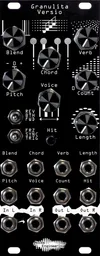A few weeks back, we released Gamut Repetitor, our quad looping generative pitch sequencer. And a couple of months before that, we released Opp Ned, our quad arpeggiator. A number of folks asked about their similarities and differences, so today we’ll be exploring what each one does, how we like to use them, and which one might be best for your setup.
Gamut Repetitor: controlled random at its finest

Gamut Repetitor was designed to be a comprehensive generative sequencer. You tell it how you want it to create melodies, and it generates patterns; when you hear something you like, set a loop length and it’ll repeat until you generate something new.
Gamut Repetitor has parameters for root note and scale, the range of random notes generated from the root note (from zero semitones to two octaves), and the bias of notes generated above versus below the root. It also has a length parameter that can either generate random voltages continuously, or loop a set of random voltages, with loop lengths from 1-32 steps.
Gamut Repetitor has four channels: all parameters are shared between channels, but the notes generated on each channel are different. Each channel can be advanced individually, or from a common clock via input normalization. Gamut Repetitor also has trigger outputs, which can either pass through the input triggers, or generate and loop new rhythms based on probability.
All of Gamut Repetitor’s parameters can be CV controlled, and it features a global reset button and input to keep loops in phase with other sequencers in your system, if desired.
Because Gamut Repetitor was designed with generative patterns specifically in mind, it doesn’t save state. If that’s what you’re looking for, you may want to consider…
Opp Ned: arpeggios are a go

Opp Ned is a four-output arpeggiator. Arpeggios can be programmed and saved in 12 save slots, and different arpeggio patterns can be loaded manually or with CV. Opp Ned has switches for octave range (1, 2, or 3 octaves), playback direction (up, up then down, or down), and playback behavior (linear, jumping steps, or random), with CV over all switches. Opp Ned’s four channels share an arpeggio pattern, and can be advanced individually with their respective trigger inputs. It also features a reset input for keeping things in phase, or adding a new layer to arpeggio playback with external sequencers.
Along with fully CV-able parameters, Opp Ned also features an Xpose input, allowing for the four outputs to be transposed with an external CV source, for key changes or for adding arpeggios to an existing melodic sequence. Arpeggios can be saved between power cycles, making your next set easy to reproduce.
The similarities and differences
In terms of features and broad applications, Gamut Repeitor and Opp Ned have a number of things in common. Both can be used for pitch CV sequencing based on trigger inputs. They can both generate pitch CV from a simple clock input or trigger pattern, and can easily integrate into more complex patches thanks to their completely CV-controllable interfaces.
The real differences come in their workflows and goals: Gamut Repetitor was specifically designed to generate different melodies from patch to patch, with no memory of previous patterns. A few simple parameters allow you to dial in the flavor and range of melodies you’d like it to create, and it writes patterns for you. Opp Ned, on the other hand, allows for programming, saving, and loading of different arpeggios. What arpeggio is played can be selected manually or via CV, and how a pattern plays back can be changed via the front panel settings, but it will always play notes from one of the 12 arpeggio patterns.
Gamut Repetitor is a great choice if you enjoy generative patching and randomness, or need an inspiration generator that can constantly create new patterns and melodies for your creative process. Opp Ned is a great choice if you like programming arpeggio patterns and playing them back in a variety of ways, or want to add arpeggios to existing sequencers in your system.








